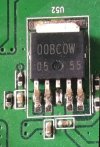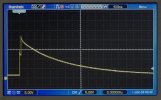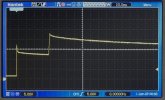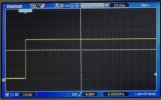Black Hole
May contain traces of nut
Taking up the baton from here:
Some initial findings:
The supply to the HDD is unswitched on the 12V rail but switched on 5V, and the 5V supply turns on when the HDR-FOX comes out of the initial boot phase (indicated by the VFD "Cust FW #.##" turning off).
The HDD 5V comes from a TO252 surface mount component marked on the PCB as "U52":

This is a 1A variable voltage low drop-out regulator with on/off control: https://fscdn.rohm.com/en/products/databook/datasheet/ic/power/linear_regulator/baxxbc0-e.pdf
It appears to work with the HDD disconnected: 5V is present on the HDD power connector at the right time and the HDR-FOX starts up correctly.
However, with a HDD connected (even a Seagate Pipeline 500GB) I can see no disturbance on the inputs to U52 (the input voltage is about 5.9V, and present all the time the unit is switched on), but the 5V rail to the HDD only reaches less than 2V. The HDR-FOX enters a continuous cycle of reboots, restarting each time the 5V should be turned on. It does this even with the SATA cable disconnected. That there is still 5.9V on the input to U52 rules out the PSU as the cause of the problem.
What I believe is happening is the HDD 5V also supplies something else on the main board, and it is that causing the reboot when the rail is out-of spec. It crosses my mind that an input-output differential of 0.9V is quite low (even for an LDO reg), but the datasheet indicates these are able to handle it down to 0.3V typical, 0.5V max (remarkable), so that isn't the problem.
U52 has over-current and thermal protective shut-down, and I suspect it is faulty and shutting down the output prematurely. My next move is to obtain a replacement part and see what happens (ordered, but estimated delivery up to 3 months!).
Something to note is that a HDD with 5V current requirement greater than 1A would not be supported.
Possible Solution (addendum 15/12/2021)
Short-cutting the next 7 pages of posts or so, forum member "Newcoppiceman" has diagnosed a failed capacitor in his unit (which exhibited similar symptoms), and enabled another user to repair theirs by replacing the same capacitor. I have not yet confirmed whether the same capacitor is at fault in my test unit – but it could be, or it might be a different one. Please refer to the following post, and posts surrounding it (click the link-through arrow button in the quote header):
Thanks for the suggestions, but I don't have a 'scope or any idea how to get the test subject onto Black Hole's bench.
I have purchased a docking statation with an eSata output and a eSATA to SATA cable for connecting my HDD, whilst powering it externally.
But the humax doesn't always detect the HDD. Some fiddling about with connections and restarting sometimes works, but often I get webif messages "The system is initialising" followed by "No internal disk found". There is an "Access Telnet Menu" option.
Any suggestions on how to help humax find the HDD? Perhaps a System Command line instruction?
Some initial findings:
The supply to the HDD is unswitched on the 12V rail but switched on 5V, and the 5V supply turns on when the HDR-FOX comes out of the initial boot phase (indicated by the VFD "Cust FW #.##" turning off).
The HDD 5V comes from a TO252 surface mount component marked on the PCB as "U52":

This is a 1A variable voltage low drop-out regulator with on/off control: https://fscdn.rohm.com/en/products/databook/datasheet/ic/power/linear_regulator/baxxbc0-e.pdf
It appears to work with the HDD disconnected: 5V is present on the HDD power connector at the right time and the HDR-FOX starts up correctly.
However, with a HDD connected (even a Seagate Pipeline 500GB) I can see no disturbance on the inputs to U52 (the input voltage is about 5.9V, and present all the time the unit is switched on), but the 5V rail to the HDD only reaches less than 2V. The HDR-FOX enters a continuous cycle of reboots, restarting each time the 5V should be turned on. It does this even with the SATA cable disconnected. That there is still 5.9V on the input to U52 rules out the PSU as the cause of the problem.
What I believe is happening is the HDD 5V also supplies something else on the main board, and it is that causing the reboot when the rail is out-of spec. It crosses my mind that an input-output differential of 0.9V is quite low (even for an LDO reg), but the datasheet indicates these are able to handle it down to 0.3V typical, 0.5V max (remarkable), so that isn't the problem.
U52 has over-current and thermal protective shut-down, and I suspect it is faulty and shutting down the output prematurely. My next move is to obtain a replacement part and see what happens (ordered, but estimated delivery up to 3 months!).
Something to note is that a HDD with 5V current requirement greater than 1A would not be supported.
Possible Solution (addendum 15/12/2021)
Short-cutting the next 7 pages of posts or so, forum member "Newcoppiceman" has diagnosed a failed capacitor in his unit (which exhibited similar symptoms), and enabled another user to repair theirs by replacing the same capacitor. I have not yet confirmed whether the same capacitor is at fault in my test unit – but it could be, or it might be a different one. Please refer to the following post, and posts surrounding it (click the link-through arrow button in the quote header):
Replacing the Mosfet (U24) and the 4u7 cap in the HDD 12V switching circuit has fixed our faulty PVR; it is an ex-faulty PVR. The conclusion, then, is that the likely culprit for any problem embraced by this thread’s title (or something similar, especially if temperature-related) is that 4u7/35V SMD cap. I replaced it with a 4u7/25V conventional electrolytic (there’s never more than 12V across it, so the derating is ok). Remember, I blew-up the Mosfet (still don’t see how) - it wasn't responsible for the original fault.
The details of how the PVR detects a problem with a slow-starting HDD 12V and forces a restart (and why, at other times, such as for scheduled recordings from standby, it’s not bothered) remain a mystery. As does why it boots ok with the HDD disconnected.
Last edited:





